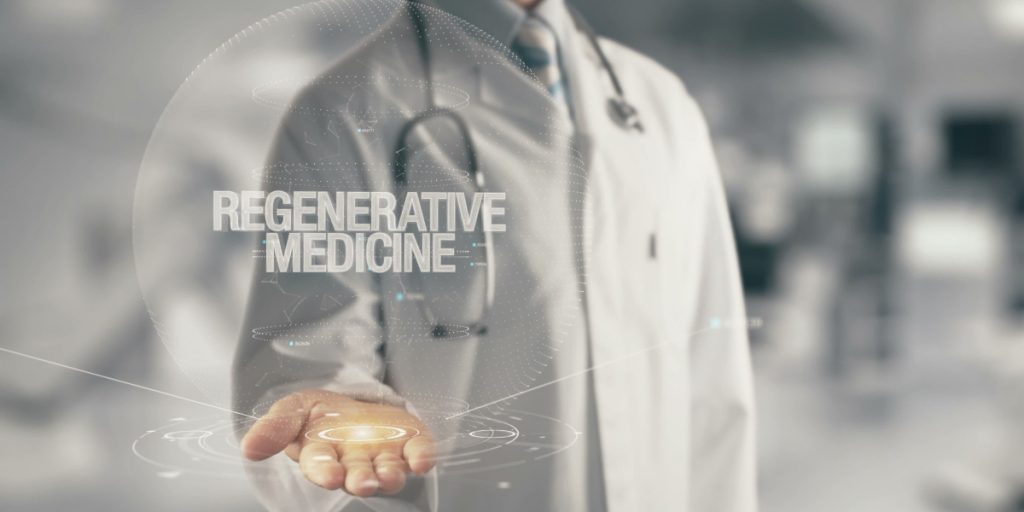Are you worried about the impact coronavirus might have on your health, as well as your family’s health? Are you worried that an effective vaccine may still be a year away?
Coronavirus has already had a horrible impact on people in countries around the world — even those who are young and healthy. The virus hasn’t gone away like many people first thought it would. It now looks like it’s here to stay.
While we wait for vaccine development, a unique approach is showing potential for the treatment of COVID-19 related complications: regenerative therapy.
You might have heard of regenerative therapy. If not, you may have heard of stem cell research. Well, stem cell research is what’s behind regenerative therapy.
While some forms of stem cell therapies are highly technical (like growing human organs in a lab), there are forms of regenerative therapy that use the same principles but in a less invasive and more accessible way. The basic idea is to stimulate the body to repair and reproduce tissue damaged through injury and disease.
Best of all, stem cell research news is now suggesting regenerative therapy can be used to fight COVID-19.
Countries around the world are developing new types of medical treatments to help COVID-19 patients. Here’s how regenerative therapy is helping thwart coronavirus.
What Is Regenerative Medicine?
Regenerative therapy is a broad term describing a number of different treatments designed to help stimulate the human body to repair itself. You may have heard of stem cell procedures, which are probably the most well-known form of regenerative therapy.
The basic process of regenerative therapy is the stimulation of the body to produce and repair cells at the site of injuries and diseases. There are a number of different ways that regenerative therapy can do this.
It often involves taking existing human cells and introducing them to areas of the body that are unable to generate their own new cells because of disease or other trauma. Also, scientists have now been able to produce medicine from cells that they have harvested themselves.
This means that transplanting living tissue is not necessary. It also means that the body will not reject the introduced tissue, as used to happen when organs were transplanted from donors that were not genetically compatible with the patient.
How Is Regenerative Therapy Used?
The most common way that regenerative medicine is administered is through direct injections or intravenous (IV) infusion into the body. That means that cells were being physically introduced to an affected area, where they would then reproduce.
However, regenerative therapy is now available in a number of different forms, including medicine that you can consume as a pill. This is good news since it means a number of different conditions (even severe ones) can be treated non-invasively.
There are lots of different conditions that regenerative medicine is useful for. For example, regenerative therapy has been used to help treat conditions such as the following:
- Repairing skin after severe burns
- Repairing organs damaged by disease
- Reproducing cells destroyed by cancer
- Regrow tissue after significant physical trauma
- Fight off arthritis
- Transplantation of organs grown in a laboratory
- Helping the body fight coronavirus
The commonality between each of these different areas of treatment is that they all use human cells, proteins, and genes to help regrow damaged tissue. The idea is very simple: help the body produces its own resources to protect and restore itself.
These treatments have been available for a few decades now. Importantly, a number of them have received Food and Drug Administration approval. That means these treatments have been shown to restore the body in a safe and healthy way.
Regenerative Therapy and COVID-19
The main impact that COVID-19 is having on individuals’ health is in deteriorating their airways and lungs. Acute Respiratory Distress Syndrome (ARDS) and sepsis are two of the most common results of a severe contraction of COVID-19.
Experimental treatment of COVID-19 has injected infected patients with cells that hold regenerative power. The idea is to help regulate the body’s natural immune response to the disease and to stimulate regrowth of damaged tissues, particularly in the lungs and airways.
COVID-19 has been shown to be particularly harmful because it triggers the immune system to overreact to the virus. In trying to fight off the virus itself, the body is damaging its own cells. Therefore, regenerative medicine helps to regulate this response and maintain healthy cells in the body’s respiratory system.
While most of the trials that have so far been conducted on regenerative medicine and COVID-19 have involved hospital administrations (usually injections), new forms of regenerative therapy have become a reality. Now, you can take regenerative medicine on your own to restore damaged organs and other tissues.
Make sure you visit www.kiwidrug.com for all your medicinal needs.
Get Proactive About Your Family’s Health
There has never been a more important time to take steps to ensure your family’s health is a priority. Nobody knows when the COVID-19 virus will be stopped by a vaccine, or whether it might stop by natural causes. Either way, it’s important that you don’t just wait for these things to happen.
Life is going to go back to normal and your family is going to be exposed to the virus, as well as to other health issues.
Stem cell news is telling us that regenerative therapy is an intriguing solution for combating COVID-19. Listen to the experts and make the most of this promising new medicine. It may save your life or someone in your family’s life.
There are lots of different ways that you can help protect your health, as well as your family’s health. Why not check out some of our other great articles on health advice today? Be proactive about your health.
